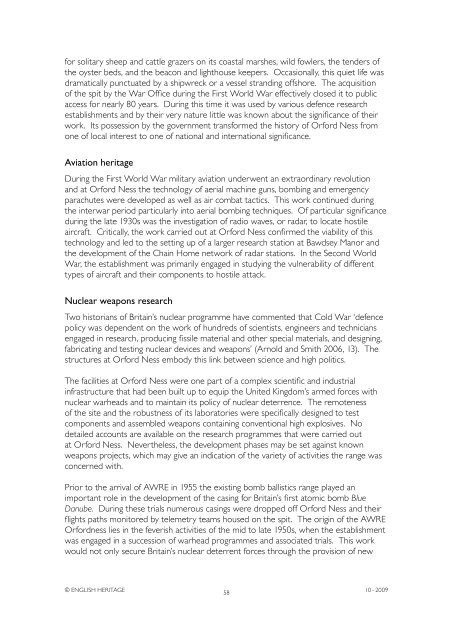Atomic Weapons Research Establishment. Orford ... - English Heritage
Atomic Weapons Research Establishment. Orford ... - English Heritage
Atomic Weapons Research Establishment. Orford ... - English Heritage
You also want an ePaper? Increase the reach of your titles
YUMPU automatically turns print PDFs into web optimized ePapers that Google loves.
for solitary sheep and cattle grazers on its coastal marshes, wild fowlers, the tenders of<br />
the oyster beds, and the beacon and lighthouse keepers. Occasionally, this quiet life was<br />
dramatically punctuated by a shipwreck or a vessel stranding offshore. The acquisition<br />
of the spit by the War Office during the First World War effectively closed it to public<br />
access for nearly 80 years. During this time it was used by various defence research<br />
establishments and by their very nature little was known about the significance of their<br />
work. Its possession by the government transformed the history of <strong>Orford</strong> Ness from<br />
one of local interest to one of national and international significance.<br />
Aviation heritage<br />
During the First World War military aviation underwent an extraordinary revolution<br />
and at <strong>Orford</strong> Ness the technology of aerial machine guns, bombing and emergency<br />
parachutes were developed as well as air combat tactics. This work continued during<br />
the interwar period particularly into aerial bombing techniques. Of particular significance<br />
during the late 1930s was the investigation of radio waves, or radar, to locate hostile<br />
aircraft. Critically, the work carried out at <strong>Orford</strong> Ness confirmed the viability of this<br />
technology and led to the setting up of a larger research station at Bawdsey Manor and<br />
the development of the Chain Home network of radar stations. In the Second World<br />
War, the establishment was primarily engaged in studying the vulnerability of different<br />
types of aircraft and their components to hostile attack.<br />
Nuclear weapons research<br />
Two historians of Britain’s nuclear programme have commented that Cold War ‘defence<br />
policy was dependent on the work of hundreds of scientists, engineers and technicians<br />
engaged in research, producing fissile material and other special materials, and designing,<br />
fabricating and testing nuclear devices and weapons’ (Arnold and Smith 2006, 13). The<br />
structures at <strong>Orford</strong> Ness embody this link between science and high politics.<br />
The facilities at <strong>Orford</strong> Ness were one part of a complex scientific and industrial<br />
infrastructure that had been built up to equip the United Kingdom’s armed forces with<br />
nuclear warheads and to maintain its policy of nuclear deterrence. The remoteness<br />
of the site and the robustness of its laboratories were specifically designed to test<br />
components and assembled weapons containing conventional high explosives. No<br />
detailed accounts are available on the research programmes that were carried out<br />
at <strong>Orford</strong> Ness. Nevertheless, the development phases may be set against known<br />
weapons projects, which may give an indication of the variety of activities the range was<br />
concerned with.<br />
Prior to the arrival of AWRE in 1955 the existing bomb ballistics range played an<br />
important role in the development of the casing for Britain’s first atomic bomb Blue<br />
Danube. During these trials numerous casings were dropped off <strong>Orford</strong> Ness and their<br />
flights paths monitored by telemetry teams housed on the spit. The origin of the AWRE<br />
<strong>Orford</strong>ness lies in the feverish activities of the mid to late 1950s, when the establishment<br />
was engaged in a succession of warhead programmes and associated trials. This work<br />
would not only secure Britain’s nuclear deterrent forces through the provision of new<br />
© ENGLISH HERITAGE<br />
58<br />
10 - 2009

















